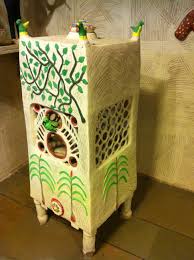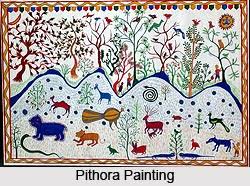Painting of Chattisgarh
- Indian paintings provide an artistic continuum that extends from the early civilization and culture to the present day.
- From being essentially religious in purpose in the beginning, Indian painting has evolved over the years to become a fusion of various cultures and traditions.
- The Indian painting was exposed to Greco-Roman as well as Iranian and Chinese influences.
Classification of Indian Paintings
- Indian Paintings can be broadly classified as the mural paintings and miniature painting.
- Murals are huge works executed on the walls of solid structures, as in the Ajanta Caves and the Kailashnath temple. They are also called as wall paintings.
- Miniature paintings are executed on a very small scale on perishable material such as paper and cloth.
Paintings of Chattisgarh
- Paintings are perhaps the most expressive of the handicrafts of Chhattisgarh, which aesthetically encapsulates the various facets of life, tradition and culture of the tribal people of Chhattisgarh.
- Every picture or painting depicts and show the traditional tribal rituals. The traditional paintings originated in the tribal regions of the central India and spread in various region of Chattisgarh. The area is that include in the present states of Madhya Pradesh and Chhattisgarh.
- There are numerous types of folk paintings that speak of the distinctive art and culture of the state of Chhattisgarh. The most famous of these are:
- Traditional wall Painting of Chattisgarh- this kind of paintings depicts pictures of traditional tribal rituals. Most of the paintings are related to the celebrations of their customary ceremonies. The walls and the floors are painted with vibrant colors making a brilliant picturesque view.
- Pithora painting- this is a different kind of traditional painting. These paintings are usually made during childbirth, marriages, and other ceremonial occasions and functions of wish fulfillment
- The tribal people consider the paintings as fortunate and over the years, the paintings have become parts of their lives and culture.
- The traditional paintings of Chhattisgarh are very famous as rural forms of art.
| Tribe Name | Painting of Chattisgarh |
| Gond Tribe | Gond Painting |
| Muria Tribe | Muria Painting |
| Abhuj Maria Tribe | Abhuj Maria Painting |
| Dhurvaa Tribe | Dhurvaa Painting |
| Bison Horn Maria Tribe | Bison Horn Maria Painting |
Common Feature of Tribal – Wall Painting of Chattisgarh
Wall Painting
- The tradition of wall paintings has been passed down from pre-historic times to today.
- As society moved from forest dwellings to agricultural-based communities, the art of painting continued as a part of their life, tradition, culture and to transmit their traditional beliefs through their art.
- Wall painting forms part of the universal culture of most agricultural societies and forest dwelling societies.
- Paintings are done on walls to invoke the gods to bless the soil, keep animals healthy for work in the field, grant a family healthy progeny after marriage, and bless a newly constructed home.
- Paintings found on the walls of religious buildings depict a human quest to understand a larger universe, natural life and power.
Current tradition of wall painting in Various Tribal Regions
- In a wall painting or mural, the ground is the wall or the stone of the cave. Paint is applied on to the wall plaster. To bind the paint to the plaster the colours are often put on wet plaster so that it fuses with it.
- In many tribal region and villages in India women apply wet lime paint to the dry mud walls. Lime is a natural disinfectant and prevents ants and termites inhabiting the walls.
- As they use no adhesive the paint flakes and has to be redone every season, especially after the monsoons just before Dussehra and Diwali.
- Wall painting also done during ceremonial function like Marriage.
Picture – Wall Painting, Sarguja, Chhattisgarh
Rock Art Site and Painting of Chattisgarh
- The first discovery of rock art in Chhattisgarh was made in 1910 by C.W. Anderson, an engineer in the Bengal/Nagpur Railways, ably assisted by C.J. Wellington (from 1910 to 1913).
- Mention of such work, especially at Singhanpur in Raigarh Dist., was made in 1918 (Anderson, 1918)
- It was followed by the works of P. Brown (1923), A.N. Dutta (1927), M. Ghosh (1932), L.P. Pandey (1933), D.H. Gordon (1939), J.P. Gupta (1960, 1967), P. Mitra (1961) and S.K Pandey, (1969) and V.S. Wakankar (1973), adding significantly to our knowledge about rock art in this area..
- Chhattisgarh is very rich in rock paintings ranging in age from Mesolithic to Historical period and some of the rock paintings date back even to prehistoric period. Many of the rock paintings throw interesting light on the life ways, culture, tradition and art of Early Man.
- Rock art sites in the Chhattisgarh are located in the district of Raigarh at Singhanpur, Kabra Pahar, Basnajhar, Ongna, Karmagarh, Khairpur, Botalda, Bhanwarkhol, Amargufa, Gatadih, Siroli Dongri, Bainipahar etc.
| Sl. No. | Rock Site | District | Feature of Rock Art |
| 1 | Gotitola a)Pancha Pandav b)Near Tank | Kanker | Scene Pertaining to relation (Ram, Sita, Laksman etc.) Figures of tree leaves, Palm impressions |
| 2 | Limdariha | Baster | Human and Animal Figure |
| 3 | Singhanpur | Raigarh | Ladder men, Mermaid, Animal figures, Hunting scenes, Kangaroo, Giraffe |
| 4 | Bhanwarkhol | Bison, Mermaid, Bear, Hunting scenes, Geometric pattern, Swastik | |
| 5 | Udkunda a)Dewata Ki Kachahari b)Chanda Pathara c)Adaya Pahar | Kanker | Palm and Feet impressions, Animal figures |
| 6 | Kherkheda a)Balerao b)Naukar Gudara c)Gadia Gudara | Kanker | Animal and Human figures, Palm impressions, Human Figure |
| 7 | Chitwa Dongri | Durg | Chinese figure, Dragon, Agricultural activity |
Pithora Painting
- Pithora Paintings are much more than colorful images on walls for the tribes of Chattisgarh.
- They indicate the advent of an auspicious occasion (like weddings, childbirth, festivals) in the family or community.
- An art form, which essentially conveys the enjoyment and celebration of a community, has to reflect the collective mood of it, and Pithora paintings with their colors and energetic figures mirrors the sentiments of their creators.
- The essence of a Pithora painting lies in its earthiness; everything from the theme to the execution has the ethnicity of rural India.
- Even materials used are quite exotic: the colors are prepared by mixing pigments with milk and liquor prepared from the Mahuda tree. Indeed the enthusiasm of the community couldn’t have found a more suitable mean of expression.
Picture of Pithora Painting

